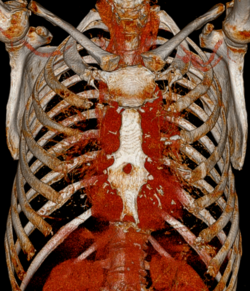Medicine:Sternal foramen
Sternal foramen (or perforated sternum) is an oval foramen present at lower one-third of the sternum. It is a relatively common anatomical variation found in 2.5% to 13.8% of individuals.[1]
Structure
This variation is usually present at the lower one-third of the sternal body. It has an oval shape and a unique "bow tie" appearance when seen on axial computed tomography. The diameter of the sternal foramen ranges from 6 to 16 mm with an average diameter of 6.5 mm.[2] Sometimes, the foramen can be present at the xiphod process. In extremely rare cases, the foramen is found at the manubrium.[3]
Developmentally, sternal foramen results from the incomplete fusion of the sternal bars while they are still cartilaginous.[4]
Clinical significance
Although sternal foramen is asymptomatic, it may entail a risk of serious complications from blinded sternal interventions. The foramen may be misdiagnosed as sternal fracture or a gunshot wound. Awareness of sternal foramen is also crucial in acupuncture to avoid cardiac tamponade.[5]
Additional images
See also
References
- ↑ Choi, Paul J; Iwanaga, Joe; Tubbs, R. Shane (2017). "A Comprehensive Review of the Sternal Foramina and its Clinical Significance". Cureus 9 (12): e1929. doi:10.7759/cureus.1929. ISSN 2168-8184. PMID 29456905.
- ↑ Tandon, Aseem; Gara, Rama Devi (2016-01-01). "Sternal foramen" (in en). Medical Journal of Dr. D.Y. Patil University 9 (1): 127. doi:10.4103/0975-2870.167974. ISSN 0975-2870. https://www.mjdrdypu.org/article.asp?issn=0975-2870;year=2016;volume=9;issue=1;spage=127;epage=128;aulast=Tandon;type=0.
- ↑ Bayaroğulları, Hanifi; Yengil, Erhan; Davran, Ramazan; Ağlagül, Ela; Karazincir, Sinem; Balcı, Ali (2014). "Evaluation of the postnatal development of the sternum and sternal variations using multidetector CT". Diagnostic and Interventional Radiology (Ankara, Turkey) 20 (1): 82–89. doi:10.5152/dir.2013.13121. ISSN 1305-3612. PMID 24100061.
- ↑ Ashley, G. T. (1956). "The relationship between the pattern of ossification and the definitive shape of the mesosternum in man". Journal of Anatomy 90 (Pt 1): 87–105. ISSN 0021-8782. PMID 13295154.
- ↑ Chung, Ainee; Bui, Luke; Mills, Edward (2003-08-01). "Adverse effects of acupuncture. Which are clinically significant?" (in en). Canadian Family Physician 49 (8): 985–989. ISSN 0008-350X. PMID 12943357. PMC 2214278. https://www.cfp.ca/content/49/8/985.
 |





